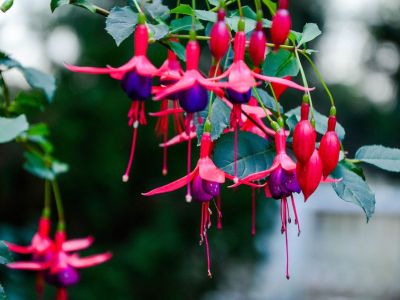Wild fuchsias, native to Central and South America, grow profusely in the Andes where temperatures are cool, and the air is moist. Fuchsias were named after a 16th century German botanist – Leonard Fuchs. They don’t require constant maintenance, but do plan on paying attention to them. Read on for more fuchsia growing tips.
Fuchsia Growing Tips
If you live in zones 6 or 7 and are growing fuchsia in your garden, you’ve probably chosen a “hardy” variety. Good fuchsia plant care entails planting them in soil with a pH level of 6 to 7. However, they’re fairly adaptable in many kinds of soil, so long as it drains well and quickly. Fuchsia roots don’t like to sit in water. Fuchsias love lots of filtered light but are particularly intolerant of heat. Making sure your fuchsia baskets or planters have plenty of dappled shade and daytime temperatures well below 80 degrees F. (27 C.) will encourage a healthy bloom. Fuchsias also prefer cooler nighttime temperatures. If you’re expecting a period of hot summer weather, it’s good to have a backup plan for sheltering your fuchsia plants to support their blooming activity through the summer. If you’re growing fuchsias indoors, a window with bright, indirect sunlight works best. However, they do like humidity and will languish if the air is too dry, whether indoors or out. Fuchsia blossoms are a wonderful treat for pollinators, so expect plenty of bees and hummers if you’re growing them outside.
Care of Fuchsias
Fuchsias will thrive and blossom more abundantly if they’re pinched back as new growth appears. When a branch has finished blooming, clip it back with clean garden shears. You can fertilize fuchsias every couple of weeks in spring and summer, but begin to taper off feeding as fall approaches. Diluted fish emulsion works beautifully. If you live in zones 10 or 11, your fuchsia may behave as a perennial, but in colder zones you may need to replant in spring or move your plants indoors for the winter. Snip off any dead leaves and stems and keep your plant in a cool dark environment, watering only every third or fourth week throughout the dormant period. It won’t look great, but in early spring with some fresh sunlight, water, and food, it should spring back to life. Fuchsia plants can be subject to various fungal infections and viral diseases. Be sure to keep the area around your fuchsias free from dead leaves, stems, and other materials and debris. Watch for problems that might develop at the junctures of stem and leaf, and treat the plants with neem oil and insecticidal soap when necessary. You may want to introduce some beneficial insects to keep the bad ones away. Fuchsias are worth the time it takes to maintain a proper environment for them. Care of fuchsias is not necessarily low maintenance, but with a little special attention their beauty is worth a bit of extra effort.
